| Srl | Item |
| 1 |
ID:
152900
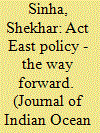

|
|
|
| 2 |
ID:
069693
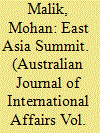

|
|
|
| 3 |
ID:
108572


|
|
|
|
|
| Publication |
2011.
|
| Summary/Abstract |
Certain developments are emerging in East Asia that could accentuate the divisions
among ASEAN members over East Asian regionalism. One is the trend toward
financial and trade cooperation between ASEAN and Northeast Asian countries
that will make it difficult for ASEAN to resist East Asian regionalism. Another is
the growing global economic importance of East Asia that can reduce ASEAN's
centrality in this regionalism. These divisions are most pronounced between
Malaysia and Indonesia. While Malaysia wants the regional grouping to be a
community, Indonesia sees it as basically functional in purpose. Malaysia, unlike
Indonesia, sees some economic, especially financial, benefit from the regional
grouping. China is not seen by Malaysia as a threat to the region and can best be
accommodated in Malaysia's preferred grouping, the ASEAN Plus Three, while
Indonesia favors the East Asia Summit where India can help balance China.
|
|
|
|
|
|
|
|
|
|
|
|
|
|
|
|
| 4 |
ID:
111164
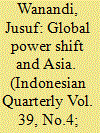

|
|
|
| 5 |
ID:
125259


|
|
|
|
|
| Publication |
2013.
|
| Summary/Abstract |
Indonesia has evolved significantly since 1998, through the pace has been at times painfully slow. In addition to that, many have argued that Indonesia`s regional and global profile is rising. Since 2003, Indonesia has been the driving force behind political and security community building in the association of Southeast Asian Nation (ASEAN), even as it strengthens bilateral partnerships with major such as the United States, China and India. Indonesia has also been vigorously engaged in many global issues such as climate change and been a fervent of global institution including the G-20. Putting Indonesia in the discussion of regional power is important because it is one of Southeast Asia`s key leaders and is also an active participant in Asia`s emerging regional security architecture. This paper analyzes Indonesia`s emergence as a regional power by looking at both its recent domestic developments and its rising global and regional profile, and argues that albeit its international ambition and recent success in rising its diplomatic game, Indonesia still rest on shaky domestic foundations.
|
|
|
|
|
|
|
|
|
|
|
|
|
|
|
|
| 6 |
ID:
083744
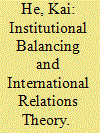

|
|
|
|
|
| Publication |
2008.
|
| Summary/Abstract |
This study integrates elements of neorealist and neoliberal theories with a model of institutional balancing that identifies the conditions under which this form of soft balancing occurs. Institutional balancing, i.e. countering pressures or threats through initiating, utilizing, and dominating multilateral institutions, is a new realist strategy for states to pursue security under anarchy. The interplay between the distribution of capabilities and strong economic interdependence shapes states' decisions on when and how to employ this strategy. Historical examples include: inclusive and exclusive efforts by Third World states and the superpowers to organize voting blocs in the UN during the Cold War; inclusive institutional balancing of ASEAN states to constrain China and ensure US support in the ASEAN Regional Forum (ARF) after the Cold War; exclusive institutional balancing of ASEAN states against the US in the ASEAN Plus Three (APT) summit after the Southeast Asian financial crisis. These examples illustrate the logic of institutional balancing under the conditions of bipolarity, incipient multipolarity, and unipolarity.
|
|
|
|
|
|
|
|
|
|
|
|
|
|
|
|
| 7 |
ID:
109474


|
|
|
|
|
| Publication |
2011.
|
| Summary/Abstract |
Although economically interdependent, political rivalry between Japan and China have brought about the inability of the Association of Southeast Asian Nations Plus Three (APT) process to transform itself into an East Asia Summit (EAS) as originally envisioned. The existence of the APT and the EAS as two separate entities not only reflected the politico-security rivalry between the two neighbours but more importantly affected the direction and progress of East Asian regionalism as a whole. Aiming to provide a historical account of the EAS process and examine Japan's role in the development of the EAS framework, this paper argues that Japan has put greater attention on the EAS and made numerous unilateral initiatives to develop it. While Japan does not seek ultimate power, it considers the EAS as an excellent opportunity to: (i) raise its influence in the region vis-à-vis China; (ii) elevate the status of the EAS in region-building and (iii) check Chinese advances by fulfilling its long-held policy of having other Asia Pacific countries, primarily Australia and New Zealand, join. Nevertheless, the decision to expand the EAS to include the USA and Russia will have some adverse effects on Japan's unilateral ambitions and the furtherance of regionalisation processes.
|
|
|
|
|
|
|
|
|
|
|
|
|
|
|
|
| 8 |
ID:
070734


|
|
|
| 9 |
ID:
111549


|
|
|
|
|
| Publication |
2012.
|
| Summary/Abstract |
Revolving around the concept of 'Community' or 'community', debate on an Asian region has ostensibly pitted those who proposed an entity limited to East Asia (China, Japan, South Korea and the ten countries of the Association of South East Asian Nations, ASEAN) against those who proposed a much wider region embracing India, North (and, perhaps, South) America, as well as Australasia. Previously these two conceptualisations possessed their eponymous translation in the East Asian Economic Caucus (reincarnated as ASEAN+3) and the Asia Pacific Economic Cooperation forum. However, with the creation in 2005 of the East Asian Summit to include India, Australia and New Zealand and, above all, its 2011 enlargement to include the United States and Russia, the contrast between the two conceptualisations of an Asian region has become confused. In order to explain this development, this article suggests that the language of 'region' or 'community' is a discursive smokescreen disguising changes in approaches to multilateralism. An examination of the East Asia Summit, contrasting it with another recent regional project, the Trans Pacific Partnership, suggests that the actors involved are seeking to ensure the primacy of individual nation states in intergovernmental multilateral relations.
|
|
|
|
|
|
|
|
|
|
|
|
|
|
|
|
| 10 |
ID:
111773


|
|
|
| 11 |
ID:
111165
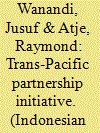

|
|
|
| 12 |
ID:
106015


|
|
|
|
|
| Publication |
2011.
|
| Summary/Abstract |
The 'hub-and-spoke' alliance structure led by the United States was - and remains - a major feature of security politics in the Asia-Pacific. This article links its 'general interests' with the larger issue of the Asia-Pacific's evolving multilateral regional order. After reviewing the concept of 'hedging', the first section problematises the literature that treats the US-led alliances which constitute the hub-and-spoke system mainly as instruments for the competitive side of a hedging strategy. The second section observes that they go beyond being instruments of threat response to becoming a more complicated network of regional multilateral order-maintenance and order-building. The third section claims that the United States and its regional allies have been utilising the hub-and-spoke alliance structure as a hedge against an undesirable multilateral order emerging in the region. The fourth section examines those arguments with reference to the East Asia Summit (EAS) and the Six Party Talks. The article concludes with some thoughts about what these findings mean for the future direction of the hub-and-spoke alliance structure in the Asia-Pacific.
|
|
|
|
|
|
|
|
|
|
|
|
|
|
|
|